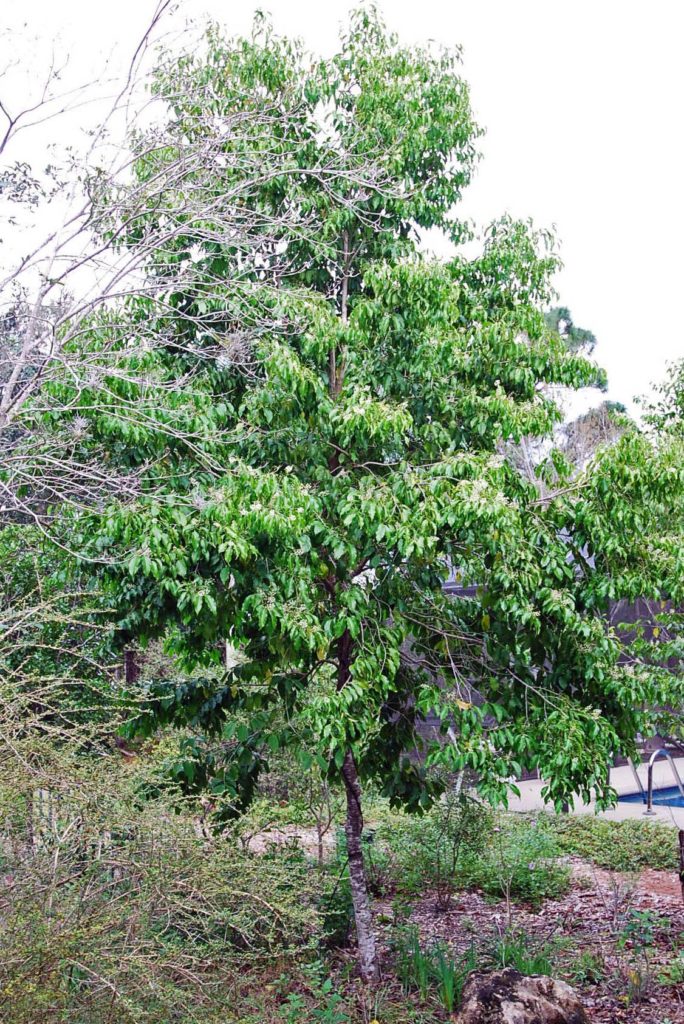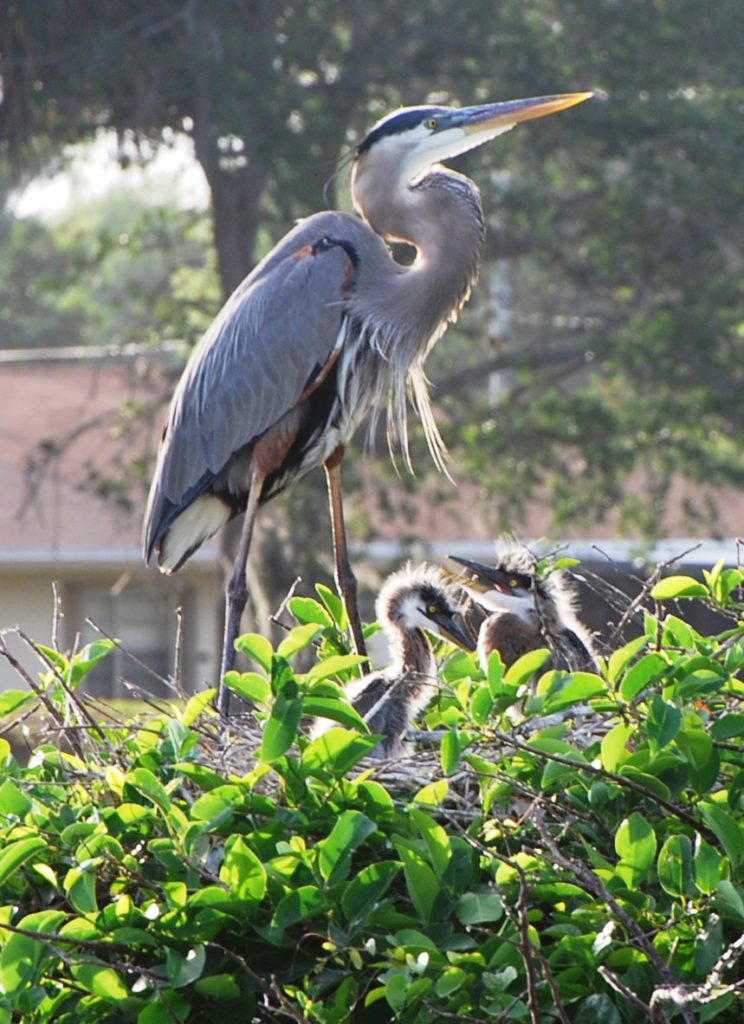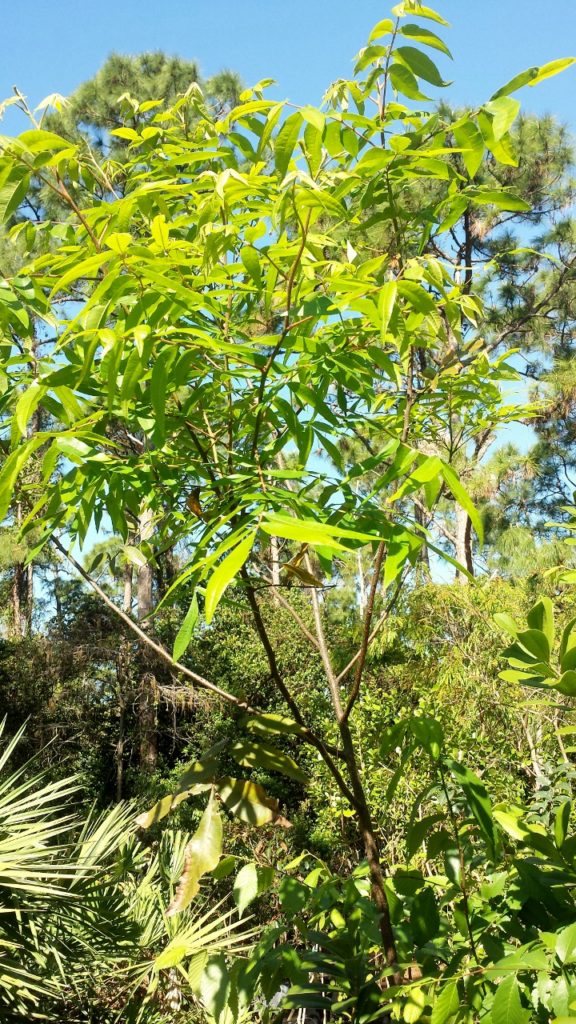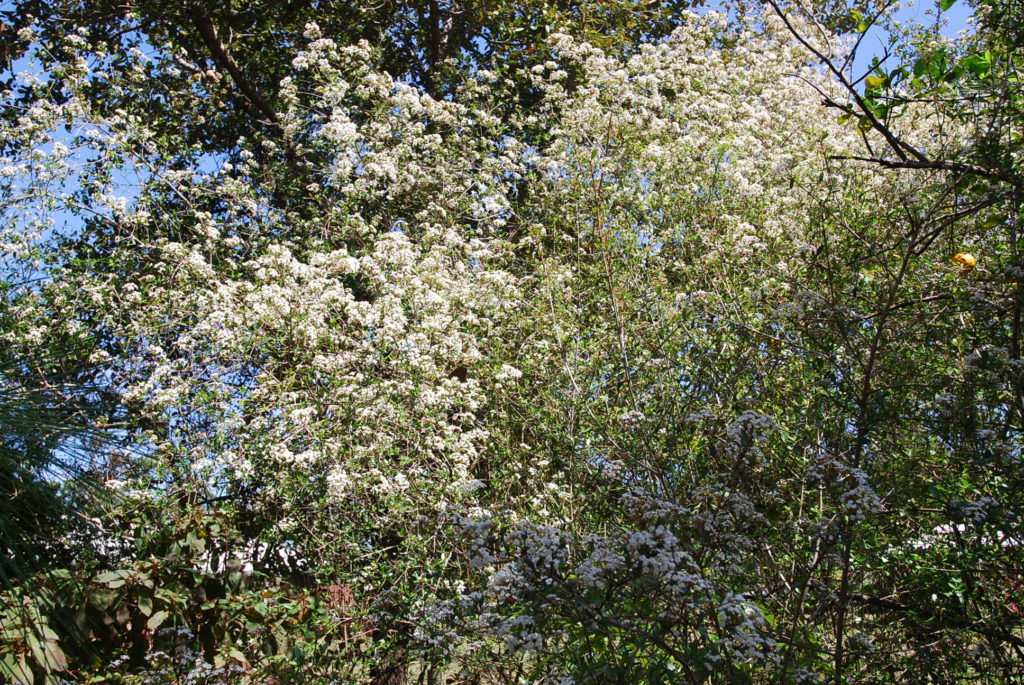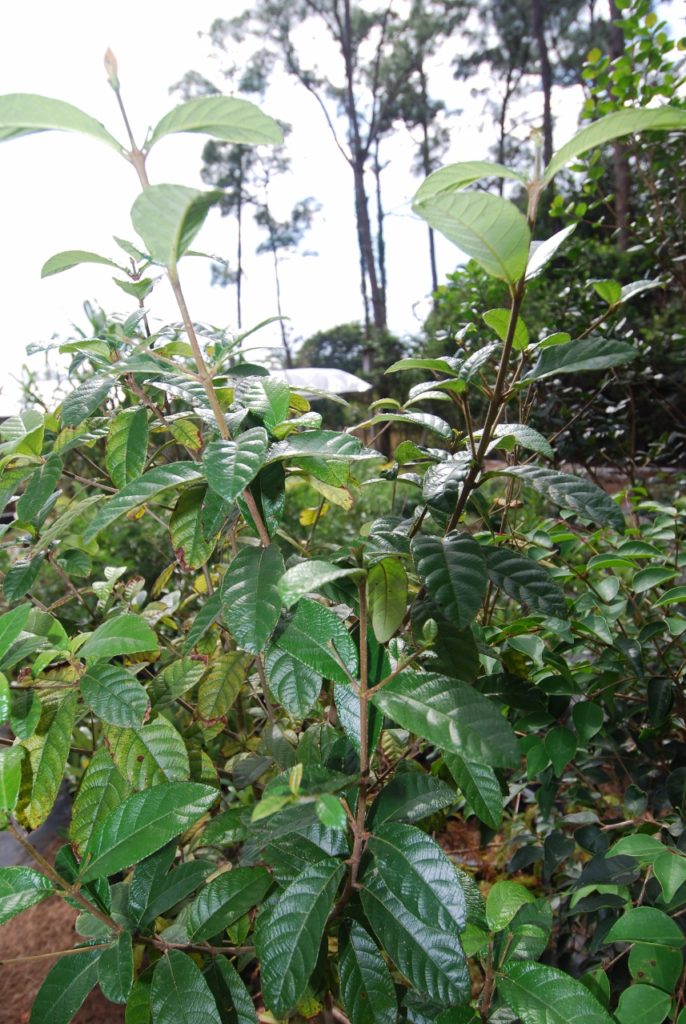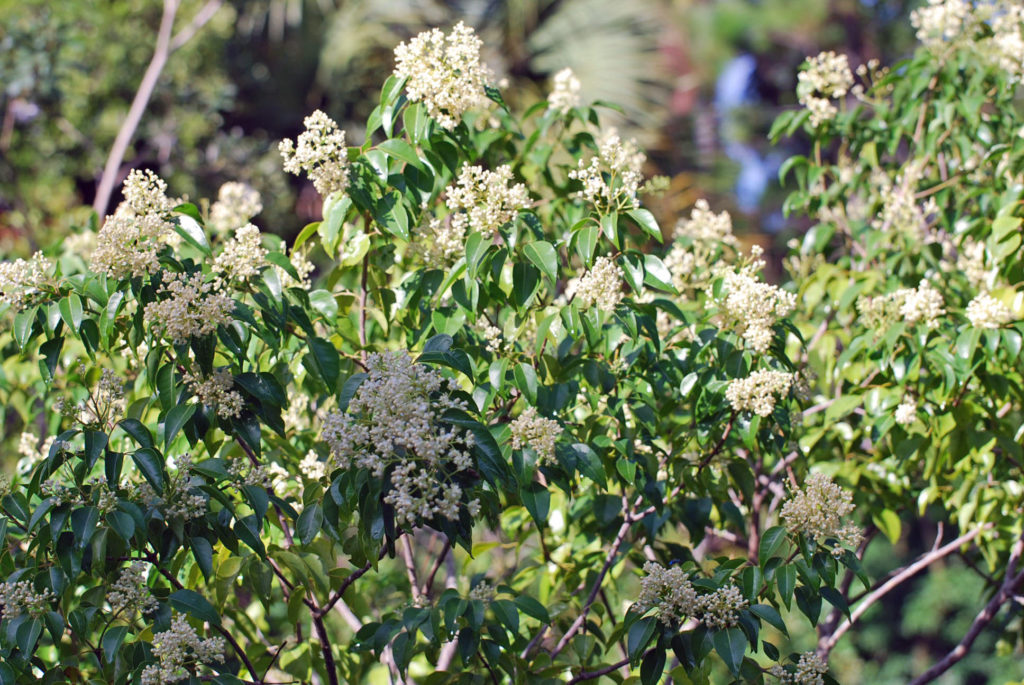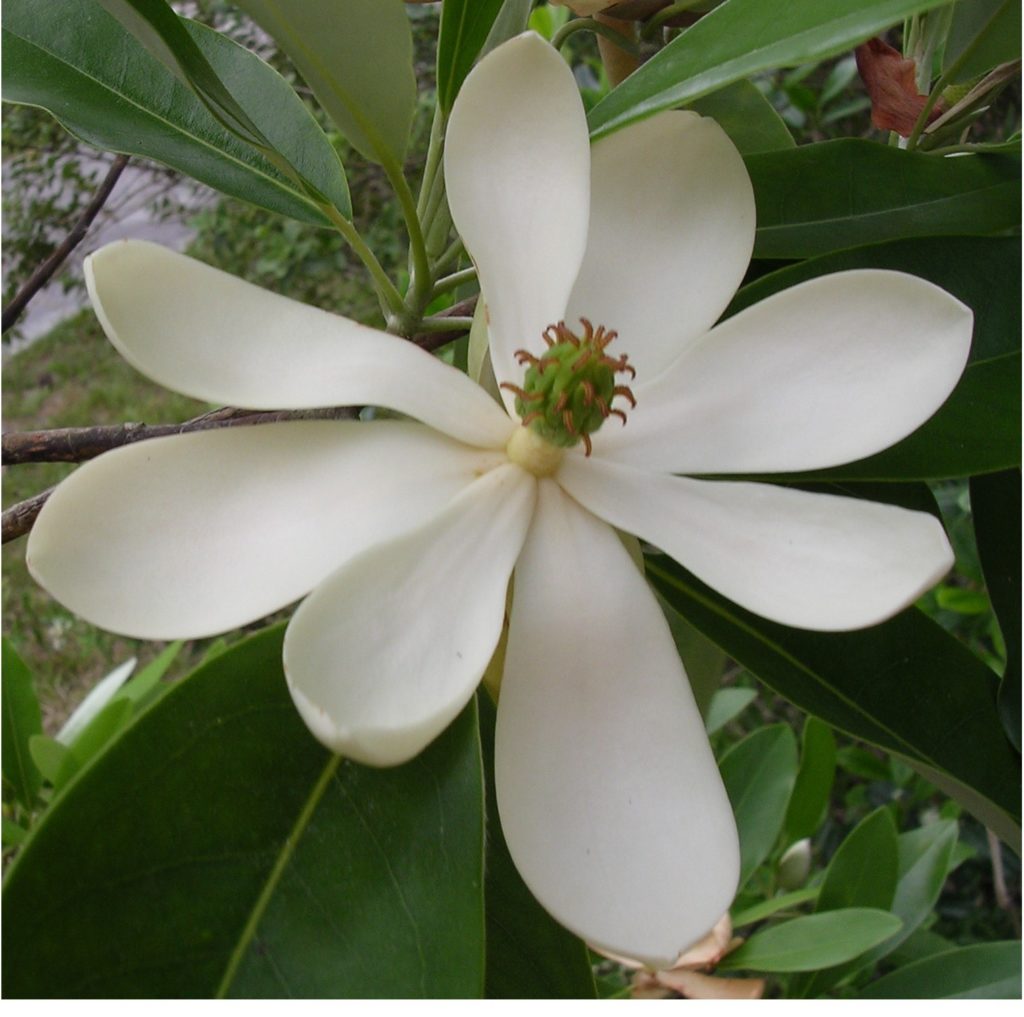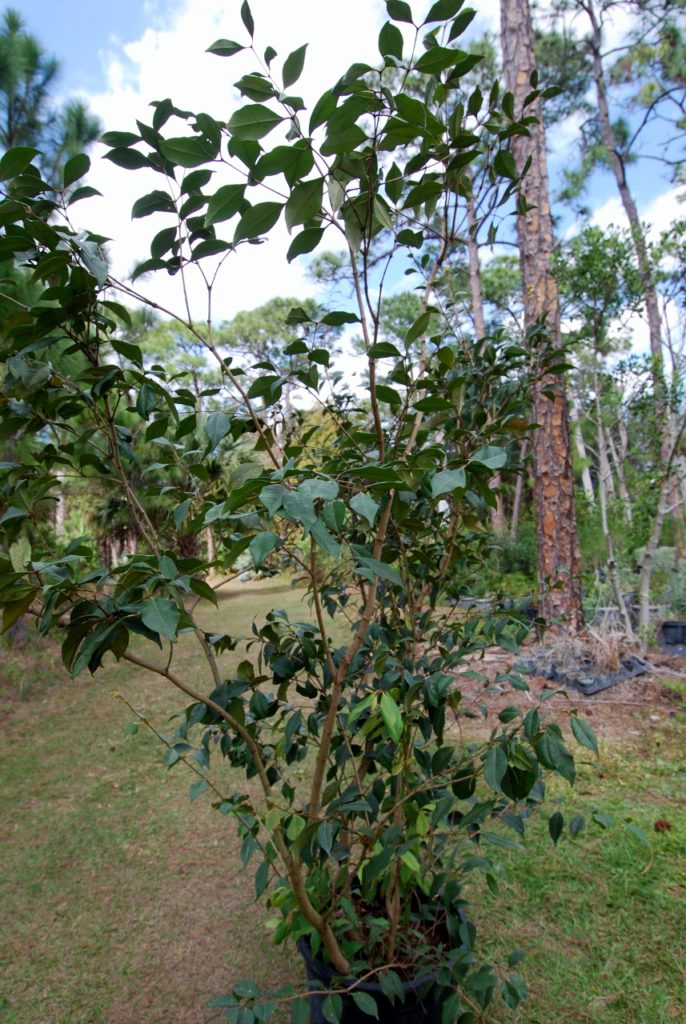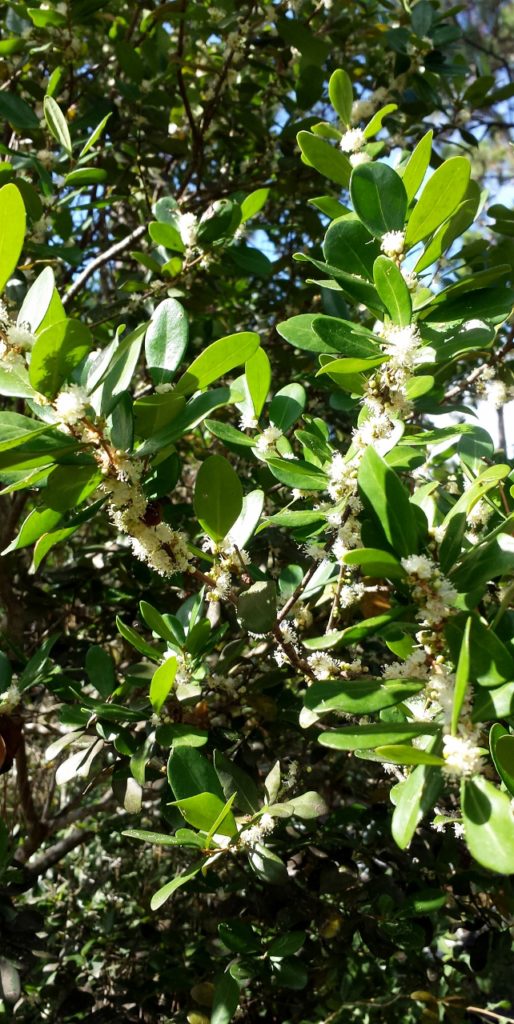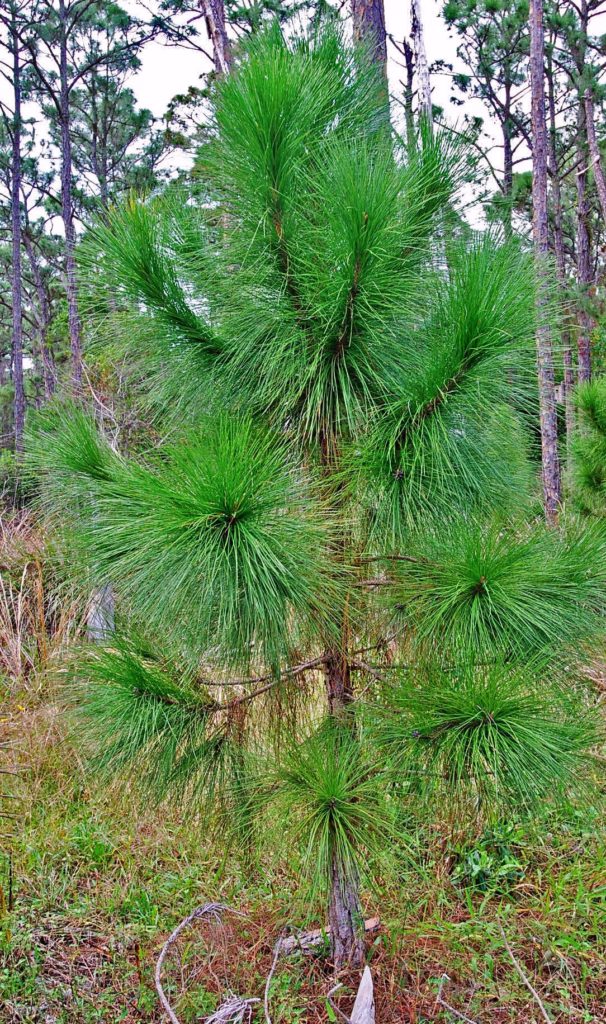West Indian Cherry
Prunus myrtifolia
The West Indian Cherry is native to the Rocklands of Dade County from Long Pine Key to the Miami River. It normally grows to 35 feet and may reach 50 or more feet over many years. This is a fairly fast growing tree that looks like a small Ficus benjamina. It can be kept at any height with occasional pruning.
West Indian Cherry is tolerant of average soil, yet prefers some organic matter to retain moisture and provide nutrients. Salt air will burn the leaves and salt water will kill it. It is cold tolerant to eastern Martin County. I have seen nice specimens where it was planted on Sewell’s Point.
The fragrant white flowers appear in winter on a Raceme and the berries ripen by summer. It may also flower in the summer for a fall crop of fruit.
Male flowers are borne on the bottom and the female flowers on the top of the raceme. Wildlife eat the small cherries. These are bitter, due to prussic acid (bitter almond), and shouldn’t be eaten, yet a taste is OK.
Squirrels really like the berries and will visit the tree continually while in fruit. If you have a squirrel crazy dog, this can be a bit annoying.
Use this as an upper story tree and underplant with a background of mixed shrubs like Marlberry, Wild Coffee, Stoppers, Saw Palmetto, Locust Berry, Florida Boxwood or Blackbead.
Plant the foreground with low plants so that the trunk is not hidden. Try Snowberry, Coontie, Spider Lily, or a variety of wildflowers.
Other tall trees can be mixed with West Indian Cherry. These include Gumbo Limbo, Pigeon Plum, Lance Wood, Satin Leaf, Mastic, Paradise Tree, Redberry Stopper, Bahama Strongbark, Spicewood and Soldierwood. This is a narrow tree, so spreading trees like Wild Tamarind and Live Oak may overshadow it.
You may even be surprised to find a few of the seedlings coming up around the yard where the squirrels have planted them. This design help from nature is almost always welcomed here as it gives the property a more natural look.
Click for more info.
Pond Apple
Annona glabra
Pond apple naturally grows from scattered locations in the Florida Keys up to Martin County. It can be found sparingly from there to Brevard County. It is tolerant of brackish water and some salt air, but should be protected by other vegetation if grown back of the dune.
Rich, moist soil is prefered although standing water a foot deep and soils that dry out for short periods are tolerated. This makes a good tree for the average landscape if grown in moist areas of the yard. It drops most of its leaves briefly in February.
The oblong leaves are up to seven inches long and the stems are dark brown like the twigs on an apple tree. In summer, one inch leathery flowers appear and are followed by a heart shaped fruit that starts green and turns brown and splits when ripe.
This fruit is slightly sweet and can be much appreciated when found during a long August hike. The half inch seeds are plentiful and can’t be eaten. I just pull the fruit apart, scoop out the pulp with my teeth and spit out the seeds.
Many wading bird species build their nests on the top of Pond Apple branches, especially on trees growing out in the water where raccoons are afraid to venture.
Although alligators eat baby birds that drop from their nests, they also eat raccoons and other creatures that would raid the nests and eat all the eggs. It’s a trade off.
Also, there are now several species of lizards including the Green, Black Spinytail and Mexican Spinytail Iguanas that have the potential to raid bird nests. Hopefully the alligators will eat some of these too. Click for more info.
Pond Apple can be planted on the edge or in the water along lake or pond edges, canal banks, salt marshes and within retention ponds. Its roots will help clean the water within and entering these water bodies.
Build up the other tree species with Red Maple, Hackberry, Laurel and Live Oak, Slash Pine, Water Hickory, Pop Ash and Cypress (both of which can also be planted in the water), and Sweet Bay Magnolia.
Understory should be wetland herbs like Pickerelweed, Duck Potato, Giant Leather Fern, American Crinum Lily, Prairie Iris, Florida Lily, Marsh, Swamp, Hottentot and Virginia Chain Ferns.
The south rim of Lake Okeechobee was once lined with tall Pond Apple trees thick with dense, woven horizontal branches. Too bad they were removed to make way for sugarcane.
There are two wetland preserves in Palm Beach County which are actually water purification marshes associated with two sewage treatment plants. These are the Wakodahatchee and Green Cay Wetlands. Take a trip there from early February to May and you will see many wading birds nesting in the Pond Apples that are planted in the shallow water.
There are green herons, great blue herons, great egrets, wood storks, anhingas, cormorants, Louisiana herons, cattle egrets, and other bird species creating a cacophony of sound. There are also many other bird watchers sharing self evident, (“a priori knowledge”), as they try to make sense of the weird bird behaviors that they see.
Click for more info. And more info.
Water Hickory
Carya aquatica
Water Hickory is naturally found in floodplain soils from the eastern Carolinas to northern Palm Beach County and west to East Texas. It prefers rich, moist soil, yet will grow well in average soil. This becomes a tall, straight trunked tree with shaggy bark.
The deciduous pinnate leaves are up to 18 inches long and have as many as 17, six inch long leaflets. The underside of the leaf is rusty colored and the top is dark green. I like the bare trees in winter, they remind me of up north for a month or so.
Male and female flowers occur separately on the same tree. The flowers are wind pollinated and the pollen may cause allergies for some people. Squirrels, turkey, wood ducks and other wildlife eat the nuts. The meat is bitter, yet not poisonous.
Water Hickory is an important part of floodplains, as it removes excess nutrients from the soil and water. Think of our polluted retention pits in every parking lot in Florida and our community ponds. A mixture of Cypress, Red Maple, Water Hickory and Pond Apple planted in these depressions would clean the water and turn these wet areas into wildlife sanctuaries.
How about planting these trees along our canals? There are long stretches of culverts burying the canals to make room for more parking lots. The culverts should be removed and the now open banks planted with trees.
I like the mix of Water Hickory with Florida Elm, Red Maple, Red Mulberry, Hackberry, Persimmon, Cypress, Southern Red Cedar, Sweetgum, Pond Apple, Pop Ash, Slash Pine and Florida Royal Palm. The understory can be fern, Wild Coffee, Virginia Willow, Marlberry, Native Plumbago, and many other shade tolerant species.
Maybe it’s time to give large trees a home in South Florida and stop fretting over the remote possibility that in 100 years it might fall on your house. Do you drive? Now that’s scary.
Click for more info.And more info.
Walter’s Viburnum
Viburnum obovatum
Walter’s Viburnum is also called Small Viburnum and is native to the edges of rivers and other wetlands north of Palm Beach County thru the Southeastern U.S.. It is commonly found naturally just north of Lake Okeechobee and west of the lake.
Moderately fertile soil with some organic matter is best. It is not tolerant of salt air or saltwater flooding.
This is a suckering shrub that forms a thicket of sprouts that fill in and create a dense hedge. It can be clipped or allowed to form a natural screen. The dark green elliptic leaves are 1-1.5 inches long.
The numerous heads of fragrant, small white flowers bloom in March and April. These are followed by green, turning to red and finally black, small flat berries. These ripen in August and are eaten by wildlife. The fruit, with a single flat seed, has a sweet licorice flavor.
The best site to grow Walter’s viburnum is one with moist soil and moderate organic matter. It is tolerant of dry soil once established.
Plant as a hedge or along a lake edge mixed with Myrsine, Wax Myrtle, Dahoon Holly, Saw Palmetto, Marlberry, Cocoplum, Virginia Willow, Red Maple, Laurel Oak, Slash Pine, Florida Elm, Hackberry, Elderberry and Swamp or Marsh Fern as a ground cover.
Small Viburnum should not be planted where it’s suckering habit may become a problem. Give it plenty of room to wander.
Click for more info.
Rough Velvetseed
Guettarda scabra
Rough Velvetseed is native to the Florida Keys up to the Miami River. Many are found in the Everglades Park rocklands (Long Pine key) and the areas around Key Largo.
The rough oval leaves are usually four inches long, yet if growing in shade, they may be six inches long and resemble Geiger leaves. It grows as a small tree 15 or more feet tall and can be pruned to become bushy.
The white, star shaped flowers are fragrant and the scattered edible berries are deep red. These have short hairs giving them a fuzzy feel. They are great for birds and other wildlife.
This is a picky tree that needs rich organic soil and will not tolerate salt air or water. Some extra watering may be needed during drought if the plant is not fully established. This may take a couple of years depending on the soil.
A fertilizer for acid loving plants with plenty of micronutrients may be needed if the leaves start turning yellow. Cold tolerance seems to be fine in eastern Palm Beach County.
Use Rough Velvetseed as an addition to a rockland or Keys hammock planting. It can be fit into spaces among other narrow shrubs and trees or used as a specimen in the open.
As an understory tree, try blending with Gumbo Limbo, Wild Tamarind, Pigeon Plum, Willow Bustic, Poisonwood, West Indian Mahogany, Mastic and Live Oak.
Other shrubs or small trees to associate this with include, Spanish Stopper, West Indian Lilac, Myrsine, Marlberry, Wild Coffee, Bahama Wild Coffee, Bahama Strongbark, Snowberry, Coontie, White Stopper, Everglades Velvetseed, Pineland Privet and Pineland Acacia, Saw Palmetto, Mexican Alvaradoa, Redberry Stopper and Red Stopper.
Click for more info.
Torchwood
Amyris elemifera
Torchwood is native from Central to South Florida and the Keys along the East Coast. This is a Citrus relative and a larval food for both the giant swallowtail butterfly and the Schaus’ swallowtail butterfly. The latter is found in the Florida Keys.
The pea sized edible black berry has one seed and is a good source of food for birds in January and February. It can tolerate light frost and drought once established and some salt air if protected by other coastal vegetation. The new trifoliate leaves are reddish, turning dark green and glossy at maturity.
Torchwood makes a great, free standing specimen in the front yard or can be mixed with other coastal shrubs. It goes well with Lignum Vitae, Bahama Strongback, Myrtle of the River, Spicewood, Gumbo Limbo or most hammock species. It needs full sun to light shade to grow. Quailberry, Beach Creeper and Coontie make beautiful ground covers that will show off Torchwood.
Whitefly and other scale insects can be a problem and may require organic insecticides to control. The white Sri Lanka Weevil will notch the leaves and the wood is very brittle. The clusters of fragrant white flowers and black pea sized berries make this a colorful addition to the landscape.
Click for more info.
Sweet Bay Magnolia
Magnolia virginiana
Sweetbay Magnolia is a beautiful, smooth, white barked tree with fragrant six inch white flowers followed by red fleshy seeds dangling from a cone. It is found in all of the eastern U.S. and along the gulf coast to Texas.
It grows naturally along the edge of marshes in tree islands and other acidic, moist, raised ground high in organic matter. Sweet Bay will die if flooded for more than a few days.
It does well on the edge of ponds, or lakes where leaves and other organic matter accumulate. With our southeast winds, this tends to be the northwest corner.
Sweet Bay will form a colony by suckering and makes a great screen while young, yet it will eventually reach 40 feet tall with a nice clean trunk.
Under plant with ferns like the Giant Leather, Marsh, Hottentot or Swamp Fern. Try a rim of shrubs including Wild Coffee, Marlberry, Swamp Dogwood, Virginia Willow, Wax Myrtle and Saw Palmetto. Cypress, Dahoon Holly, Swamp Red Bay, Pond Apple, Slash Pine and Red Maple look nice nearby.
Sweetbay Magnolia is the larval food for the eastern tiger swallowtail and will attract this butterfly to unexpected areas like eastern Palm Beach County. The seed source should be local. Add fertilizer with iron if the leaves turn yellow.
Squirrels, turkey, quail, and other birds and wildlife eat the red seed cover. It is not tasty or poisonous.
This is one of our few flowering trees that makes a beautiful mass and flowers at the same time as Loblolly Bay, which has a three inch white flower with a yellow center. Both need the same kind of soil.
If you have a low, mucky area of the yard, don’t fill it with sand and sod over it, plant a mass of Sweet Bay Magnolia and other wetland plants. Place a bench or chair along the edge and enjoy viewing the wildlife attracted there.
Click for more info.
Spicewood
Calyptranthes pallens
Spicewood, or Pale Lidflower, is native to the Miami Rock Ridge sporadically from The Miami River to the lower Florida Keys. It is absent from the middle Keys. Spicewood grows in well drained, moist, rich soil and tolerates drought.
It can be planted near the coast in areas well back of the dune where only limited amounts of salt air can reach it.
This is not a good hedge plant due to the wispy, open growth of its branches. It does make an excellent small tree with a rounded form. The flowers are fragrant and white and attract honeybees.
The edible pea sized berries are the source of color for this tree. They occur in clusters that change from green to orange, red, yellow, and finally black. When the last four occur together, the effect is delightful.
The pointed leaves have tiny rusty colored hairs on them when young and the bark is brown with gray mottling. This is a great source of berries for birds in late summer.
Since this should be used as a tree, try mixing Spicewood with Gumbo Limbo, Pigeon Plum, the Stoppers, Myrtle of the River, Paradise Tree, Crabwood, West Indian Cherry, Wild Tamarind, Fiddlewood, Lancewood and other hammock trees.
The understory can be any mix of coastal species and wildflowers. The main pest is Lobate Lac Scale. This small hard scale is dark brown and covers small branches. It sucks the sap from the stems. The sugar syrup that it releases after straining out the proteins drops to the leaves below. This sugar syrup then turns black as mold grows on it.
I use organic insecticides labeled for scale insects to control this pest which was accidentally imported from India along with plant material.
Click for more info. And more info.
Spanish Stopper
Eugenia foetida
Spanish Stopper is native from the Keys to Brevard County along the coast. This is a slow growing shrub that will become a 20 foot tree. The upright growth allows Spanish Stopper to be planted in tight spaces.
The one inch oval leaves and compact growth make this a nice clipped hedge. The slow growth, drought, and cold tolerance mean very little maintenance.
Plant in deep, dry soil with some organic matter. Moderate amounts of salt air and short term salt water flooding are tolerated. Plant back of the Seagrape zone.
In late summer the plant is covered with white, fragrant masses of small flowers. The tart, edible berries ripen slowly and are black by December. This is a good shrub to have when few others are providing fruit for birds.
The fibrous root system with no tap root make this hard to establish. It requires rich soil, and frequent watering with an open ended hose to penetrate the soil during establishment. Sprinkling does little to wet the soil.
Once established, no further maintenance is needed. This may take a couple of years in very dry soil. Even after establishment, water once a week during a drought if the leaves start to turn brownish.
Spanish Stopper can be planted near a doorway, as a specimen or in a mix with Marlberry, Wild Coffee, Wild Lime, Saw Palmetto, Fiddlewood, Jamaica Caper, Firebush, Crabwood and other coastal shrubs.
For a thick, tall hedge that needs very little to no maintenance after establishment, Spanish Stopper is one of the best.
Click for more info.
South Florida Slash Pine
Pinus elliottii
From the mid peninsula to the Florida Keys, South Florida Slash Pine was the dominant tree in South Florida before the arrival of Europeans. Not to be confused with the North Florida variety which does poorly in South Florida soils and climate.
It is able to grow in soils ranging from periodically wet to very dry and is tolerant of moderate salt air when planted behind coastal trees. The tap root makes this an extremely drought tolerant tree.
Although hurricanes have damaged yard trees that were weakened by over watering, most naturally occurring trees tolerated the high winds with minimal damage.
The leaves, which come in 2’s and 3’s, can be up to 12 inches long and give the young plants a bushy appearance. Many insects feed on the foliage and seeds or live in the bark and dead wood.
These insects provide food for many bird species, especially woodpeckers and warblers. The cones are filled with oblong, lentil sized seeds which are food for birds and squirrels.
Every yard in South Florida should have at least one of these trees in it. This would recreate the habitat that historically supported much of our wildlife.
The tall Slash Pines enable birds to move through the area without being exposed to predators. Even a dead pine provides nest sites for woodpeckers, osprey, and other creatures.
Under plant with saw Palmetto, Coontie, Beautyberry, Andropogon Grasses and other native grasses and wildflowers or just let the needles fall on bare ground.
If you must have lawn grass under this tree, do not water or you will weaken and possibly kill your pines. Lawn should be reduced to small areas of drought tolerant species or replaced with mulch.
The soil is more moist and shaded under the pines, so watering should not be needed. Do not bag the needles as they add organic matter to the soil.
Try to rake the needles under the tree for a grass free area. This will help keep the soil ph low and you won’t have to drive the mower over the trees’ roots.
Imagine our communities connected by Slash Pines, broken by areas of various types of hammocks (oak, coastal, wetland) and cypress domes, or expanses of native grasses and wildflowers. Restoring these habitats would result in an increase in our bird populations.
What if we didn’t have to worry about water use, salt water intrusion or pollution of our aquifer by lawn chemicals? We could also enjoy quiet summer months with the lawn mowers, weed eaters, blowers etc. sitting idle.
Click for more info.
